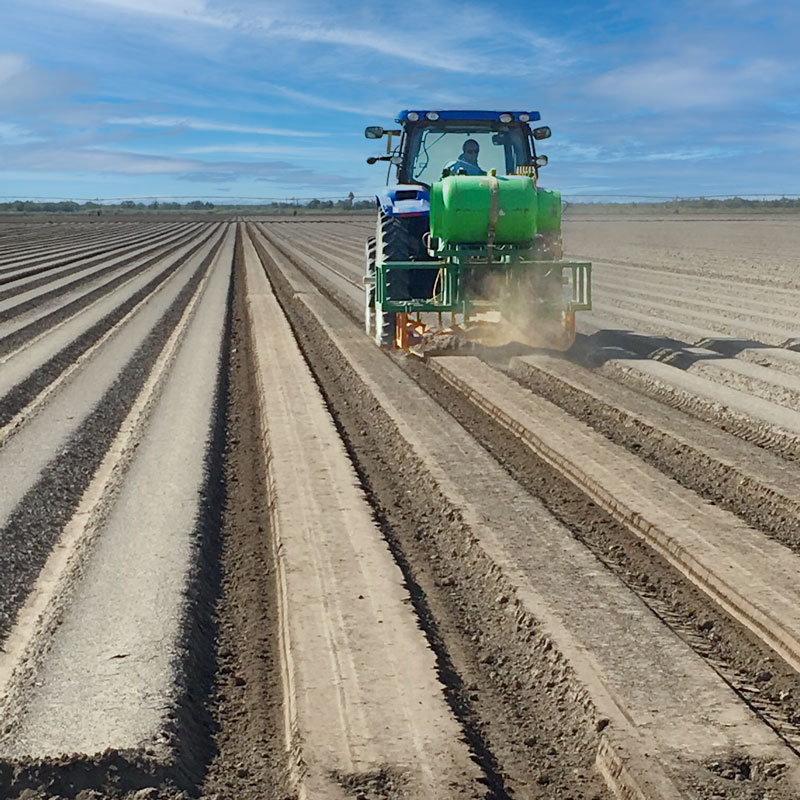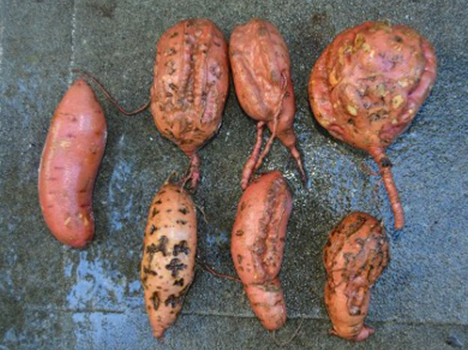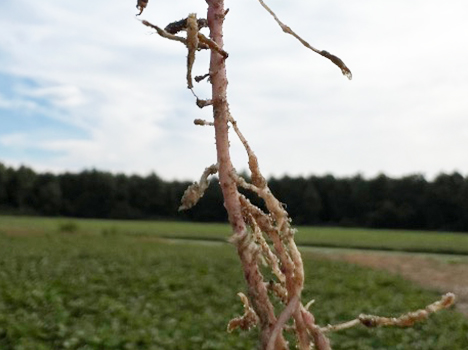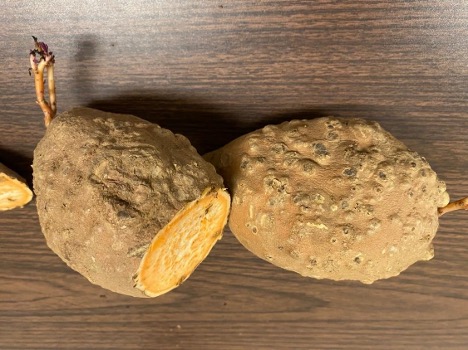THE PROBLEM
Nematodes are a common pest in sweetpotato-growing areas. They are typically found in coarse-textured soils. Root knot nematodes are the predominant species, with the guava root knot nematode (Meloidogyne enterolobii) being particularly destructive. These enterolobii nematodes are larger, more aggressive feeders that can easily overtake a field. They have a shorter (20-23 day) lifecycle compared to most root knot species (28-31 days), and there are currently no sweetpotato varieties resistant to enterolobii nematodes. Nematodes attack developing plant roots, resulting in damage that manifests itself in many ways throughout the season..
COMMON PESTS
TELONE™ SUPPRESSES:
- Guava Root-Knot Nematode
- Southern Root-Knot Nematode
- Root-Knot Nematode
- Northern Root-Knot Nematode

THE SOLUTION
Due to the nature of nematodes—where they’re found, how they move, what affects them—the most effective product for nematode control is TELONE™ soil fumigant. There are currently no alternatives to match the efficacy of TELONE™ when it comes to managing nematode populations. Soil fumigation allows the product to reach nematodes deep in the soil, allowing growers to prep their soil ahead of planting.
TELONE™ does more than just control nematodes, though. It allows sweetpotatoes to grow stronger roots and establish into healthier plants. By creating a zone of protection around roots in the first 6 to 8 weeks of growth, TELONE™ allows roots to develop in an environment where nematodes are controlled. The result is extensive, healthy root systems capable of producing high-yielding, high-quality sweetpotatoes with increased marketable yields, and improved grower ROI. Growers who export their sweetpotatoes can also rest assured that TELONE™ leaves behind zero residuals and sweetpotatoes grown in soil prepped by TELONE™ are allowed for sale in the EU.

BENEFITS
Pre-planting treatment with TELONE™ controls nematodes resulting in healthy roots that promote beneficial soil microorganisms, resulting in:- Improved Sweetpotato Quality
- Overall Reduced Inputs (less water, less fertilizer, less pesticides)
- Enhanced Soil Health
- Zero Residuals on Harvested Sweetpotatoes
Application Method:
Sweetpotato growers can broadcast apply TELONE™ or apply in-row, offering maximum application flexibility. Ask your TELONE™ Specialist which application method is best for your sweetpotato fields.NEMATODE DAMAGE

NEMATODE DAMAGE EXAMPLE
Examples of nematode damage in sweetpotatoes.

NEMATODE DAMAGE EXAMPLE
Examples of nematode root damage in sweetpotatoes.

NEMATODE DAMAGE EXAMPLE
Examples of nematode damage in sweetpotatoes.
TREATED vs. UNTREATED
FIELD TRIAL RESULTS:
The field trial data shown below was collected in 2023 in Goldsboro, North Carolina. The trial was conducted to evaluate the efficacy of TELONE™ II (1,3-Dichloropropene) pre-plant soil fumigation for managing Guava Root-Knot nematodes in sweetpotatoes as compared to an untreated control. The test area covered approximately 0.6 acres and plots were 4 rows by 100 feet.MARKETABLE YIELD AND NEMATODE COUNTS AT HARVEST
KEY TAKEAWAYS: TELONE™ II @ 8 GPA treatment increased marketable yields by more than 10x as compared to untreated control. Nematode counts were reduced by more than 15x, allowing for more sweetpotatoes to mature into healthy plants and leading to higher marketable yields.
JAPAN FIELD TRIAL
Sweetpotatoes are the most important crop for TELONE™ in Japan. This crop is highly susceptible to nematodes, which negatively impact both yield and quality. Over the years, some Japanese sweetpotato farmers have been opting for contact nematicides to manage nematodes. Sweetpotatoes are planted in the spring in Japan, and harvested in the fall. Often because of bad weather or limited time ahead of planting, growers opt for contact nematicides.
This trial was conducted to see if we could take the application methods and timing used in the USA and apply these in Japan. In the USA, growers broadcast apply TELONE™ in the autumn, and nematodes are suppressed throughout the winter ahead of spring or summer planting—giving growers much more flexibility in application timing.
The Japan team conducted a field trial comparing a broadcast application of TELONE™ in the early winter in one field, and a treatment of TELONE™ in the spring in another field. There was also a control field for comparison.
The results were on par with what we see in the USA—we can confirm that the TELONE™ manages nematodes almost equally in both the winter or spring treatments, and could improve yields as compared to the non-treated field.
This is exciting news for sweetpotato growers in Japan, because it means that growers have an extended window of time for applying TELONE™ ahead of planting, without losing efficacy against destructive nematodes.


